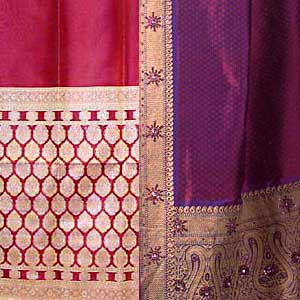A sari / saree is the traditional female garment in Bangladesh, India, Nepal and Sri Lanka. The sari is usually worn over a petticoat (pavada/pavadai in the south, and shaya in eastern India), with a blouse known as a choli or ravika forming the upper garment. The choli has short sleeves and a low neck and is usually cropped, and as such is particularly well-suited for wear in the sultry South Asian summers. Office dress codes, however, prohibit cropped, sleeveless cholis; similarly, women in the armed forces, when wearing a sari uniform, don a half-sleeve shirt tucked in at the waist.
 Styles of draping
Styles of drapingOutside India
Sri Lankan women wear saris in many styles. However, two ways of draping the sari are popular and tend to dominate; the Indian style (classic nivi drape) and the Kandyan style (or 'osaria' in Sinhalese). The Kandyan style is generally more popular in the hill country region of Kandy from which the style gets its name. Though local preferences play a role, most women decide on style depending on personal preference or what is perceived to be most flattering for their figure.
The traditional Kandyan (Osaria) style consists of a full blouse which covers the midriff completely, and is partially tucked in at the front as is seen in this 19th century portrait. However, modern intermingling of styles has led to most wearers baring the midriff. The final tail of the sari is neatly pleated rather than free-flowing. This is rather similar to the pleated rosette used in the 'Dravidian' style noted earlier in the article.
Pakistan
Saris are woven with one plain end (the end that is concealed inside the wrap), two long decorative borders running the length of the sari, and a one to three foot section at the other end which continues and elaborates the length-wise decoration. This end is called the pallu; it is the part thrown over the shoulder in the Nivi style of draping.
In past times, saris were woven of silk or cotton. The rich could afford finely-woven, diaphanous silk saris that, according to folklore, could be passed through a finger-ring. The poor wore coarsely woven cotton saris. All saris were handwoven and represented a considerable investment of time or money.
Simple hand-woven villagers' saris are often decorated with checks or stripes woven into the cloth. Inexpensive saris were also decorated with block printing using carved wooden blocks and vegetable dyes, or tie-dyeing, known in India as bhandani work.
More expensive saris had elaborate geometric, floral, or figurative ornament created on the loom, as part of the fabric. Sometimes warp and weft threads were tie-dyed and then woven, creating ikat patterns. Sometimes threads of different colors were woven into the base fabric in patterns; an ornamented border, an elaborate pallu, and often, small repeated accents in the cloth itself. These accents are called buttis or bhutties (spellings vary). For fancy saris, these patterns could be woven with gold or silver thread, which is called zari work.
Sometimes the saris were further decorated, after weaving, with various sorts of embroidery. Resham work is embroidery done with colored silk thread. Zardozi embroidery uses gold and silver thread and sometimes pearls and precious stones. Cheap modern versions of zardozi use synthetic metallic thread and imitation stones, such as fake pearls and Swarovski crystals.
In modern times, saris are increasingly woven on mechanical looms and made of artificial fibers, such as polyester, nylon, or rayon, which do not require starching or ironing. They are printed by machine, or woven in simple patterns made with floats across the back of the sari. This can create an elaborate appearance on the front, while looking ugly on the back. The punchra work is imitated with inexpensive machine-made tassel trim.
Hand-woven, hand-decorated saris are naturally much more expensive than the machine imitations. While the over-all market for handweaving has plummeted (leading to much distress among Indian handweavers), hand-woven saris are still popular for weddings and other grand social occasions.
The sari as cloth
While an international image of the 'modern style' sari may have been popularised by airline stewardesses, each region in the Indian subcontinent has developed, over the centuries, its own unique sari style. Following are the well known varieties, distinct on the basis of fabric, weaving style or motif:
Types of saris
Indian saris
Chikan – Lucknow
Banarasi – Benares
- Tant
Jamdani
Tanchoi
Shalu Northern styles
Kantha– West Bengal
Baluchari West Bengal
Ikat – Orissa Eastern styles
Paithani – Maharashtra
Bandhani – Gujarat and Rajasthan
Kota doria Rajasthan
Lugade – Maharashtra Western styles
Chanderi – Madhya Pradesh Central styles
Pochampally Andhra Pradesh
Venkatagiri – Andhra Pradesh
Gadwal – Andhra Pradesh
Guntur – Andhra Pradesh
Narayanpet – Andhra Pradesh
Mangalagiri – Andhra Pradesh
Balarampuram – Kerala
Coimbatore – Tamil Nadu
Kanchipuram (locally called Kanjivaram) – Tamil Nadu
Chettinad – Tamil Nadu
Mysore Silk – Karnataka
Ilkal saree – Karnataka Southern styles
Jamdani
Dhakai Benarosi
Rajshahi Silk
Tangail Tanter Sari
Katan Sari Bangladeshi saris
Nepalese women wear saris of many styles. Various saris are named according to the community and types of saris as well. Haku patasi worn by Jyapu community of Nepal is one of the most representative of Nepalese saris. It consists of a black sari with red margin.
Nepalese saris
The word 'sari' evolved from the Prakrit 'sattika' as mentioned in earliest buddhist jain literature. including many pictures by Raja Ravi Varma. Even today, women in some rural areas do not wear cholis. In the privacy of homes, even city women sometimes find it convenient to drape the sari as a cover-all, without the choli.
Origins and history
Saris being laundered and left to dry
A sari shop in Hyderabad
A traditional sari fabric
Group of sari-clad women wearing everyday saris
A Tamil couple; the wife is wearing a madisaar sari
See also
No comments:
Post a Comment